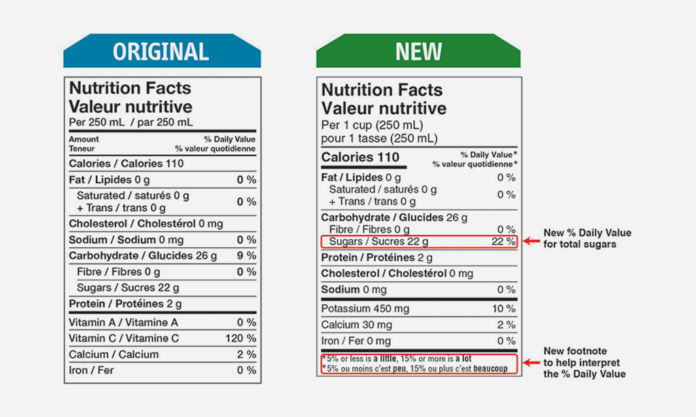Prepackaged foods containing one or more added supplemental ingredients such as vitamins, mineral nutrients, amino acids or other ingredients have historically been marketed in Canada as supplemented foods pursuant to a TMA from Health Canada. Proposed amendments to the FDR would provide a new regulatory framework for supplemented foods, overseeing the permitted supplemental ingredients and supplemental foods, and any conditions of use and sale.
Defined lists of supplemental ingredients and supplemental food categories will be introduced setting out detailed conditions of use for each ingredient in order for the supplemental foods to be sold, and specific categories of food to which supplemental ingredients may be added. Any supplemental ingredients or supplemental foods identified in the defined lists may be sold without any further regulatory approval from Health Canada. Requests may be submitted to add, remove or revise the conditions of use of a supplemental ingredient or supplemented food category from their respective lists to streamline the authorization of new products.
Existing labelling requirements for prepackaged foods under the FDR would apply to supplemental foods, as well as new labelling requirements specific to supplemental foods to help consumers distinguish these products from regular foods, understand the associated risks and make informed decisions on consumption. New labelling requirements for supplemental foods would include:
- a standard Supplemented Foods Facts Table (SFFT) in place of the Nutritional Facts Table (NFT) on the label of most prepackaged products;
- cautionary statements in both English and French for certain supplemental ingredients or certain levels of supplemental ingredients; and
- a Supplemented Food Caution Identifier (SFCI) on the label of any product containing cautionary statements.
Existing requirements for making representations on a prepackaged product’s label would also apply to supplemented foods, as well as new requirements on the use of representations on a supplemented food label, including:
- supplemented foods with cautionary statements will be prohibited from making representations about the supplemental ingredient that triggered the cautionary statement;
- for supplemented foods with cautionary statements, any permitted representation on the principal display panel, or elsewhere on the label will be subject to size restrictions compared to the size of the SFCI or the size of the cautionary statements, respectively; and
- for supplemented foods that carry the statement “high caffeine content” on their principal display panel of the label, representations related to the vitamin and mineral nutrient content in the food, physical performance, hydration or electrolyte replacement would also be prohibited.
New supplemented foods coming to market following the coming into force of the amended FDR would be required to comply with the new FDR immediately, whereas supplemented foods currently being sold under a TMA would be granted a transition period of three years once the proposed amendments to the FDR come into force.
Health Canada would continue to accept TMA applications until the coming into force date of the proposed amendments to the FDR. If a TMA is approved after the coming into force date, the product would have the remainder of the three-year transition period to comply with the FDR amendments.
New labelling requirements for natural health products
Health Canada has proposed amendments to the NHPR to improve the labelling of NHPs so that information is clear, consistent and legible for consumers and health professionals and in alignment with existing rules established for comparable non-prescription drugs.
Under the proposed amendments to the NHPR, a standardized products facts table (PFT) will be required in both French and English, under the title “Product Facts/Info-Produit,” or alternatively, “Drug Facts/Info-Médicament” displayed according to the prescribed format. The PFT would include the medicinal and non-medicinal ingredients, recommended use, warnings, directions, storage conditions, as well as a postal address, telephone number, e-mail address, or web address of the NHP product licence holder that may be used for consumers to report problems or pose questions. Any NHPs containing a food allergen, gluten or aspartame would be required to include a warning statement as well as the source of food allergen or gluten. In addition to the PFT, the NHP label would also be required to show the name of the product licence holder or importer (if applicable), the recommended route of administration, the lot number and the expiry date.
The proposed amendments to the NHPR also set out requirements on the location and orientation of the PFT, as well as font types, minimum type size and contrast of all statements, information or declarations required by the NHPR on the label of the NHP (both within and outside of the PFT).
The proposed amendments to the NHPR are expected to come into force three years following publication in the Canada Gazette, Part II, with the exception of amendments to the NHPR to clarify existing rules, which would come into force on the date of publication in the Canada Gazette, Part II.
New NHPs coming to market following the coming into force of the amended NHPR would be required to comply with the new NHPR immediately, whereas all NHPs marketed in Canada prior to the coming into force date of the proposed amendments to the NHPR would be given an additional transition period of three years to comply with the new labelling requirements, amounting to a total transition period of six years following publication in the Canada Gazette, Part II.









